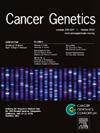23. Detection of somatic tumor mutations in circulating plasma DNA of patients with sellar and skull base tumors
IF 1.4
4区 医学
Q4 GENETICS & HEREDITY
引用次数: 0
Abstract
The use of cell-free DNA (cfDNA) as a liquid biopsy is a promising clinical tool that allows for earlier detection of cancer, advanced therapeutic monitoring, and can even predict treatment outcomes. Its feasibility has been shown in lung, breast and prostate cancers, but there is a lack of investigation in rare CNS tumors which present unique challenges in treatment and surgical accessibility. Preoperative profiling of these tumors could help guide personalized treatment options. We performed Whole Exome Sequencing (WES) on matched plasma cell-free DNA and tumor DNA of 15 patients with CNS tumors resected at the University of Washington Medical Center. This cohort includes pituitary neuroendocrine tumors (pitNETs) which are the most common intracranial neoplasms, as well as rare tumors- craniopharyngiomas and recurrent and high-grade meningiomas. Somatic variant calling revealed an average of 368 mutations in the tumors alone, while cfDNA from the plasma harbored an average of 298,839 somatic mutations. We compared the genomic profiles of cfDNA and the respective tumor sample. A total of 11 exonic non-synonymous variants (7 SNVs, 4 INDELs) in 9 different genes were detected in matched cfDNA and tumor. Mutations on the CSPG4 and GOLGA6L9 genes were validated in 13 samples of a larger cohort of PitNET genomic DNA (n=66) and may serve as potential markers for pitNETs and their subtypes. Here we show that somatic shared somatic mutations in cfDNA and matching tumor tissue can be successfully identified through WES, demonstrating that liquid biopsy might be a feasible approach for PitNETs.
23.检测蝶鞍和颅底肿瘤患者循环血浆 DNA 中的体细胞肿瘤突变
使用无细胞 DNA(cfDNA)作为液体活检是一种很有前景的临床工具,它可以更早地检测癌症、进行先进的治疗监测,甚至可以预测治疗结果。其可行性已在肺癌、乳腺癌和前列腺癌中得到证实,但对罕见的中枢神经系统肿瘤还缺乏研究,这些肿瘤在治疗和手术可及性方面存在独特的挑战。对这些肿瘤进行术前分析有助于指导个性化治疗方案。我们对在华盛顿大学医学中心切除的 15 名中枢神经系统肿瘤患者的匹配血浆无细胞 DNA 和肿瘤 DNA 进行了全外显子组测序(WES)。这些患者包括垂体神经内分泌肿瘤(pitNETs)(这是最常见的颅内肿瘤)以及罕见肿瘤--颅咽管瘤和复发性高级别脑膜瘤。体细胞变异调用显示,仅肿瘤就平均存在368个突变,而血浆中的cfDNA平均存在298,839个体细胞突变。我们比较了 cfDNA 和相应肿瘤样本的基因组图谱。在匹配的cfDNA和肿瘤中,共检测到9个不同基因的11个外显子非同义变异(7个SNV,4个INDEL)。CSPG4和GOLGA6L9基因上的变异在一个更大的PitNET基因组DNA样本群(n=66)的13个样本中得到了验证,可作为pitNET及其亚型的潜在标记物。我们在此表明,通过 WES 可以成功鉴定 cfDNA 和匹配肿瘤组织中的共享体细胞突变,这表明液体活检可能是治疗 PitNET 的一种可行方法。
本文章由计算机程序翻译,如有差异,请以英文原文为准。
求助全文
约1分钟内获得全文
求助全文
来源期刊

Cancer Genetics
ONCOLOGY-GENETICS & HEREDITY
CiteScore
3.20
自引率
5.30%
发文量
167
审稿时长
27 days
期刊介绍:
The aim of Cancer Genetics is to publish high quality scientific papers on the cellular, genetic and molecular aspects of cancer, including cancer predisposition and clinical diagnostic applications. Specific areas of interest include descriptions of new chromosomal, molecular or epigenetic alterations in benign and malignant diseases; novel laboratory approaches for identification and characterization of chromosomal rearrangements or genomic alterations in cancer cells; correlation of genetic changes with pathology and clinical presentation; and the molecular genetics of cancer predisposition. To reach a basic science and clinical multidisciplinary audience, we welcome original full-length articles, reviews, meeting summaries, brief reports, and letters to the editor.
 求助内容:
求助内容: 应助结果提醒方式:
应助结果提醒方式:


